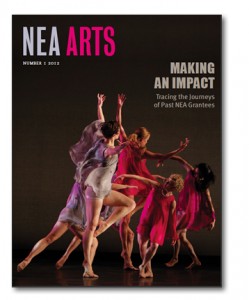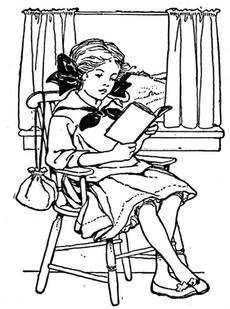NEA Arts Magazine
 The National Endowment for the Arts (NEA) has published their fine quarterly magazine since 2004. This site provides access to the NEA Arts Magazine, a great resource for anyone with an interest in the cultural milieu of the United States. Visitors can read the entire magazine as a pdf, or they can just peruse select articles. Recent articles in the magazine have covered the creative rebirth of Lowell, Massachusetts, the Steppenwolf Theatre Company, and an interview with poet Nikki Giovanni. It’s a tremendous resource for anyone with an interest in the arts and worth revisiting often.
The National Endowment for the Arts (NEA) has published their fine quarterly magazine since 2004. This site provides access to the NEA Arts Magazine, a great resource for anyone with an interest in the cultural milieu of the United States. Visitors can read the entire magazine as a pdf, or they can just peruse select articles. Recent articles in the magazine have covered the creative rebirth of Lowell, Massachusetts, the Steppenwolf Theatre Company, and an interview with poet Nikki Giovanni. It’s a tremendous resource for anyone with an interest in the arts and worth revisiting often.
>From The Scout Report, Copyright Internet Scout Project 1994-2012. http://scout.wisc.edu/
The Antidote to e-Books
Here’s a description of the Espresso Book Machine, which was introduced by On Demand Books in 2006. This “instant publishing machine” can print on-demand copies of books that are either self-published or out of print and in the public domain. It works this way:
The Espresso Book Machine uses two PDFs, one for the cover and another for the text. The cover and text, both generated from digital files, are printed simultaneously on opposite sides of the machine. They meet in the middle section of the machine, where they are bound, before dropping to a trimming station on the bottom. The book is dispensed through a chute.
The developer explains how the machine’s presence can help bookstores:
Thor Sigvaldason, the chief technology officer at On Demand Books, based in New York, said the system could help book retailers in two ways. “It can, potentially, give them a huge virtual inventory so they can have as many books as Amazon, all in a little bookstore,” he said. “It turns independent bookstores into places to get books published. It’s a new thing for the bookstore to do: not just sell books, but actually create books.”
Many of the books produced by the machine are by local self-published authors who might otherwise not have been able to get their work into print. Bookstore owners who have added the machine to their stores call it a great opportunity to engage with their customers. And the printed books provide an alternative to ebooks that some readers prefer.
I’m waiting for the machine to appear in a store near me.
Through a partnership with Xerox, the company [On Demand Books] now has machines in about 70 bookstores and libraries around the world, including London; Tokyo; Amsterdam; Abu Dhabi, United Arab Emirates; Melbourne, Australia; and Alexandria, Egypt.
Literary Introverts of My Childhood
 Introvert Sophia Dembling discusses characters from her childhood reading who helped her “be OK with who I am,” including Harriet of Harriet the Spy, Sara Crewe of A Little Princess, and Randy Melendy of the Melendy siblings series.
Introvert Sophia Dembling discusses characters from her childhood reading who helped her “be OK with who I am,” including Harriet of Harriet the Spy, Sara Crewe of A Little Princess, and Randy Melendy of the Melendy siblings series.
Introverts don’t show up much on television, Dembling says, because it’s difficult for TV to present the inner life, where most of the adventure in an introvert’s life occurs. Films do a bit better portraying introverts because they can spend more time than TV can on developing a character. “But books are full of introverted protagonists,” Dembling adds. “Right now, I’m reading The Elegance of the Hedgehog, which is all introverts.”
Dembling’s book, The Introvert’s Way: Living a Quiet Life in a Noisy World, will be released by Perigee Books in fall 2012.
Canadian Women in the Literary Arts
There is a dramatic gender imbalance in the discussion of literature in English-speaking Canada. Canadian Women in the Literary Arts (CWILA) was founded in the Spring of 2012 to address the lack of critical attention given to women’s writing in the Canadian media. Currently over 70 poets, novelists, scholars and critics from across the country are CWILA members, and our numbers are growing.
In the United States, the VIDA Count has tracked the gender disparity in American and British literary criticism. Each year, they have examined several major publications and have counted the number of articles and book reviews written by men vs. those written by women. They have also tracked the number of reviewed books written by men and women respectively. Despite the Canadian media reporting on the VIDA Count, no one has counted the numbers in Canada—so CWILA has done its own count for 2011.
CWILA examined book reviews in fourteen Canadian literary publications—including The Globe & Mail, The National Post, The Walrus, Quill and Quire, The Literary Review of Canada, and Geist—and some startling gaps were found. This despite the fact that Canadian men and women are publishing books in equal numbers. The results have been assembled on the CWILA website, and where possible comments and interviews from the editors of the publications in question have been included. We encourage other outlets to respond to our call to engage in what we hope will continue to be a productive, positive dialogue.
CWILA’s mandate is to close the gender gap in our review culture by encouraging more women to take visible roles in the community and by asking our existing editors and reviewers, male and female alike, to attend more closely to the gendered nature of the choices they make. To this end we have, in addition to the count, created a critic-in-residence position, which will pay a Canadian female or genderqueer writer a $2000 stipend to be the CWILA critic-in-residence for a calendar year. We are currently accepting donations to that fund here.
CWILA is interested in developing a critical community welcoming of all marginalized voices and sincerely hopes to contribute to the attainment of equality in the arts in Canada. We welcome you to CWILA and encourage you to join the conversation.
